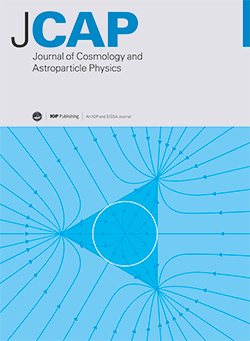Modeling the 3-point correlation function of projected scalar fields on the sphere
IF 5.9
2区 物理与天体物理
Q1 ASTRONOMY & ASTROPHYSICS
Journal of Cosmology and Astroparticle Physics
Pub Date : 2024-12-19
DOI:10.1088/1475-7516/2024/12/049
引用次数: 0
Abstract
One of the main obstacles for the signal extraction of the three point correlation function using photometric surveys, such as the Rubin Observatory Legacy Survey of Space and Time (LSST), will be the prohibitive computation time required for dealing with a vast quantity of sources. Brute force algorithms, which naively scales as 𝒪(N3) with the number of objects, can be further improved with tree methods but not enough to deal with large scale correlations of Rubin's data. However, a harmonic basis decomposition of these higher order statistics reduces the time dramatically, to scale as a two-point correlation function with the number of objects, so that the signal can be extracted in a reasonable amount of time. In this work, we aim to develop the framework to use these expansions within the Limber approximation for scalar (or spin-0) fields, such as galaxy counts, weak lensing convergence or aperture masses. We develop an estimator to extract the signal from catalogs and different phenomenological and theoretical models for its description. The latter includes halo model and standard perturbation theory, to which we add a simple effective field theory prescription based on the short range of non-locality of cosmic fields, significantly improving the agreement with simulated data. In parallel to the modeling of the signal, we develop a code that can efficiently calculate three points correlations of more than 200 million data points (a full sky simulation with Nside=4096) in ∼40 minutes, or even less than 10 minutes using an approximation in the searching algorithm, on a single high-performance computing node, enabling a feasible analysis for the upcoming LSST data.对球面上投影标量场的三点相关函数进行建模
利用光度测量提取三点相关函数信号的主要障碍之一,如鲁宾天文台遗留空间和时间调查(LSST),将是处理大量源所需的令人望而生畏的计算时间。蛮力算法,天真地缩放为物体数量的 (N3),可以用树方法进一步改进,但不足以处理鲁宾数据的大规模相关性。然而,这些高阶统计量的谐波基分解显著地减少了时间,将其缩放为与对象数量相关的两点函数,从而可以在合理的时间内提取信号。在这项工作中,我们的目标是开发一个框架,在标量(或自旋为0)场的Limber近似中使用这些展开,例如星系计数,弱透镜收敛或孔径质量。我们开发了一个估计器来从星表和不同的现象学和理论模型中提取信号来描述它。后者包括光晕模型和标准微扰理论,我们在其中加入了一个基于宇宙场非局域性短范围的简单有效场论公式,显著提高了与模拟数据的一致性。在对信号建模的同时,我们开发了一种代码,该代码可以在约40分钟内有效地计算超过2亿个数据点的三点相关性(Nside=4096的全天模拟),甚至使用搜索算法中的近似计算不到10分钟,在单个高性能计算节点上,为即将到来的LSST数据提供可行的分析。
本文章由计算机程序翻译,如有差异,请以英文原文为准。
求助全文
约1分钟内获得全文
求助全文
来源期刊

Journal of Cosmology and Astroparticle Physics
地学天文-天文与天体物理
CiteScore
10.20
自引率
23.40%
发文量
632
审稿时长
1 months
期刊介绍:
Journal of Cosmology and Astroparticle Physics (JCAP) encompasses theoretical, observational and experimental areas as well as computation and simulation. The journal covers the latest developments in the theory of all fundamental interactions and their cosmological implications (e.g. M-theory and cosmology, brane cosmology). JCAP''s coverage also includes topics such as formation, dynamics and clustering of galaxies, pre-galactic star formation, x-ray astronomy, radio astronomy, gravitational lensing, active galactic nuclei, intergalactic and interstellar matter.
 求助内容:
求助内容: 应助结果提醒方式:
应助结果提醒方式:


